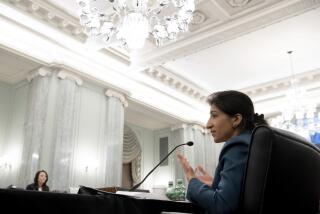FCC SAYS CABLE-TV MUST CARRY LOCAL STATIONS FOR 5 YEARS
- Share via
WASHINGTON — In a move expected to have major impact on the nation’s television industry, the Federal Communications Commission Thursday required most U.S. cable-TV companies to continue carrying some local over-the-air TV stations and non-commercial TV signals for the next five years.
The FCC ruling, expected to take effect later this year, also will require cable systems to make special switches available to the nation’s 40 million cable subscribers, enabling them to select between cable and conventional television broadcasts.
“What we are trying to do is to maximize the choice of the American people,” said FCC Chairman Mark S. Fowler.
Controversial rules that directed cable companies to carry the signals of all local TV stations had been required for more than 20 years until they were ruled unconstitutional by a federal appeals court here in July, 1985.
The new FCC ruling, approved by a 5-0 vote, includes a modified version of a compromise worked out earlier this year by the cable industry and television broadcasters.
“In many respects, the cable subscribers of the United States have become accustomed to the absence of all other means of accessing satellite and local broadcast signals once cable is installed in their homes,” said James C. McKinney, head of the FCC’s mass media bureau. “We believe it is important to correct the perception of consumers as to the actual availability of a lot of non-cable programming in the video marketplace.”
Under the new rule, which expires in five years, cable systems with fewer than 20 channels will not be required to carry any local stations. Cable operators with 21 to 27 channels will be required to devote seven channels to local stations while cable systems with more than 27 channels must set aside 25% of their total capacity for local stations.
In addition, the rule allows new TV stations to be included for a year without having to meet the current requirements for a 2% audience share.
James P. Mooney, president of the National Cable Television Assn., said the rule “is somewhat more stringent than cable bargained for. Yet, in a long-term sense, it is somewhat less permanent than the broadcasters bargained for.”
However, he said the provision exempting new stations from the 2% viewing standard required of other TV stations “is particularly galling because it seems to set up a limited class of broadcast licensees with a preference over those made-for-cable programming services, and that we did not bargain for.”
“Still, the commission forcefully and clearly rejected the notion that cable is some sort of monopoly or merely ancillary to broadcasting, and that pleases us,” Mooney added.
Edward O. Fritts, president of the National Assn. of Broadcasters, called the FCC decision “good news for American television viewers. It assures that the public will have substantial access through cable TV to the broadcast programming of network affiliates and independent commercial stations, as well as to the programming of the public broadcast system stations.”
The FCC rule also will require that all cable systems, regardless of size, carry one non-commercial educational station, a category that includes public broadcasting as well as religious broadcasters that use non-commercial TV stations. Cable systems with more than 54 channels will be required to carry at least two non-commercial stations.
FCC officials said that, in many areas, more public-TV stations are likely to be included. As a result, officials predicted, about 87% of public broadcasting stations will be carried by cable-TV stations.
At the Corp. for Public Broadcasting, President Martin Rubenstein expressed mixed reactions to the ruling.
“This rule is certainly better than the one proposed by the commercial television and cable industry,” he said.
However, Rubenstein added, “under the new rule, over 50% of all cable households could lose some of the public broadcasting programs that they now get. This situation concerns us because it makes it difficult for a unique broadcasting service to reach its audiences, as it is required to do by law.”
As part of its action on Thursday, the commission also said it would launch an inquiry into other areas including the compulsory cable license, exclusive rights to syndicated programming and nonduplication of network programming. It also plans to direct its general counsel to intervene in a court case in Los Angeles that challenges exclusive cable franchises.
The FCC decision requires cable companies to make available to consumers the switches used to flip back and forth to regular commercial broadcasting, which can be purchased for as little as $2 to $3. Many consumers already have them, but to receive commercial broadcasting, many will have to maintain outside or inside antennas.
The cable industry will be required to make the switches available to new subscribers at no cost and to existing subscribers at cost. Consumers will pay for the installation costs, estimated at about $30.
More to Read
The biggest entertainment stories
Get our big stories about Hollywood, film, television, music, arts, culture and more right in your inbox as soon as they publish.
You may occasionally receive promotional content from the Los Angeles Times.










